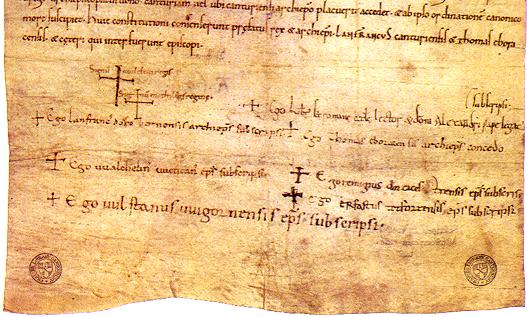Those of you who know their basic English history know that 1062 puts Wulfstan's consecration right on the edge of one of the most significant events in English history, the Norman Conquest. King St. Edward the Confessor died in early January of 1066, touching off a massive crisis as different people claimed the right to succeed him. Harold Godwinson was crowned by Ealdred. The Archbishop of Canterbury had the right to do coronations, but, remember, Stigand was excommunicated. This would throw everything off; the Anglo-Saxons couldn't leave Stigand out for political reasons, but Harold also couldn't be crowned by an excommunicated bishop, which is why he was crowned by the Archbishop of York. However, the mere fact that Stigand assisted at the ceremony gave other claimants a way to argue that Harold was not actually legitimately crowned at all. Both Duke William of Normandy and King Harald Hardrada of Norway claimed that they were the true successor of St. Edward. After initially promising gains, the Norwegian army invading from the north in September was eventually crushed by Harold Godwinson, but only at great cost. In the meantime, William began invading from the south. William, of course, would defeat Harold at the Battle of Hastings in October. The Anglo-Saxons first attempted to put forward Edgar the Ætheling as the new successor, but then they lost their nerve and surrendered. William was crowned by Ealdred on Christmas Day.
In the meantime, trouble was brewing in the Church hierarchy. Stigand died. Lanfranc was appointed to Canterbury. Ealdred also died, and a man named Thomas succeeded him. But after so many years of York having the de facto primacy, Thomas of York was not willing to let it go. This led to a grave political crisis. Thomas would eventually be forced to submit by King William. Wulfstan supported Lanfranc and signed the Accord of Winchester affirming the primacy of Canterbury. You can see his signature below, the one farthest down on the left.

But the tensions between York and Canterbury would go on for years. (You see just how much trouble one excommunicated bishop causes for everyone else!)
In addition, there were still little rebellions going on everywhere. The last of these, and one of the most significant, was that Revolt of the Earls in 1075, which occurred while William was away in Normandy. Wulfstan played an active role in putting down the revolt; as the army of one of the Earls approached Worcestershire, he raised the fyrd of the shire, the fyrd being the Anglo-Saxon equivalent of a free militia. The fyrd managed to bog the army down, preventing it from meeting up with the other army of the Earls, which then had no other reinforcements as it met an even larger force. The Revolt failed. Perhaps because of this and his support of Lanfranc, after 1075 Wulfstan was the only Anglo-Saxon bishop in England. All the others who had not died had been forced out and replaced by Normans.
He was a very active bishop through his entire tenure. He did some massive building and rebuilding in his diocese; he founded the Great Malvern Priory during the reign of Edward the Confessor. With the help of Lanfranc he broke the back of the slave trade in southern England, where Bristol had been a notable slaver port. After Lanfranc's death, there was a period of four years during which there was no Archbishop of Canterbury. St. Anselm was eventually chosen, and Wulfstan was one of his consecrators. The lapse of four years had allowed York to get its strength back, and so much of St. Anselm's tenure as Archbishop was taken up with the struggle over the primacy, although Wulfstan missed most of it. He died 20 January 1095 and was canonized by Innocent III in 1203.